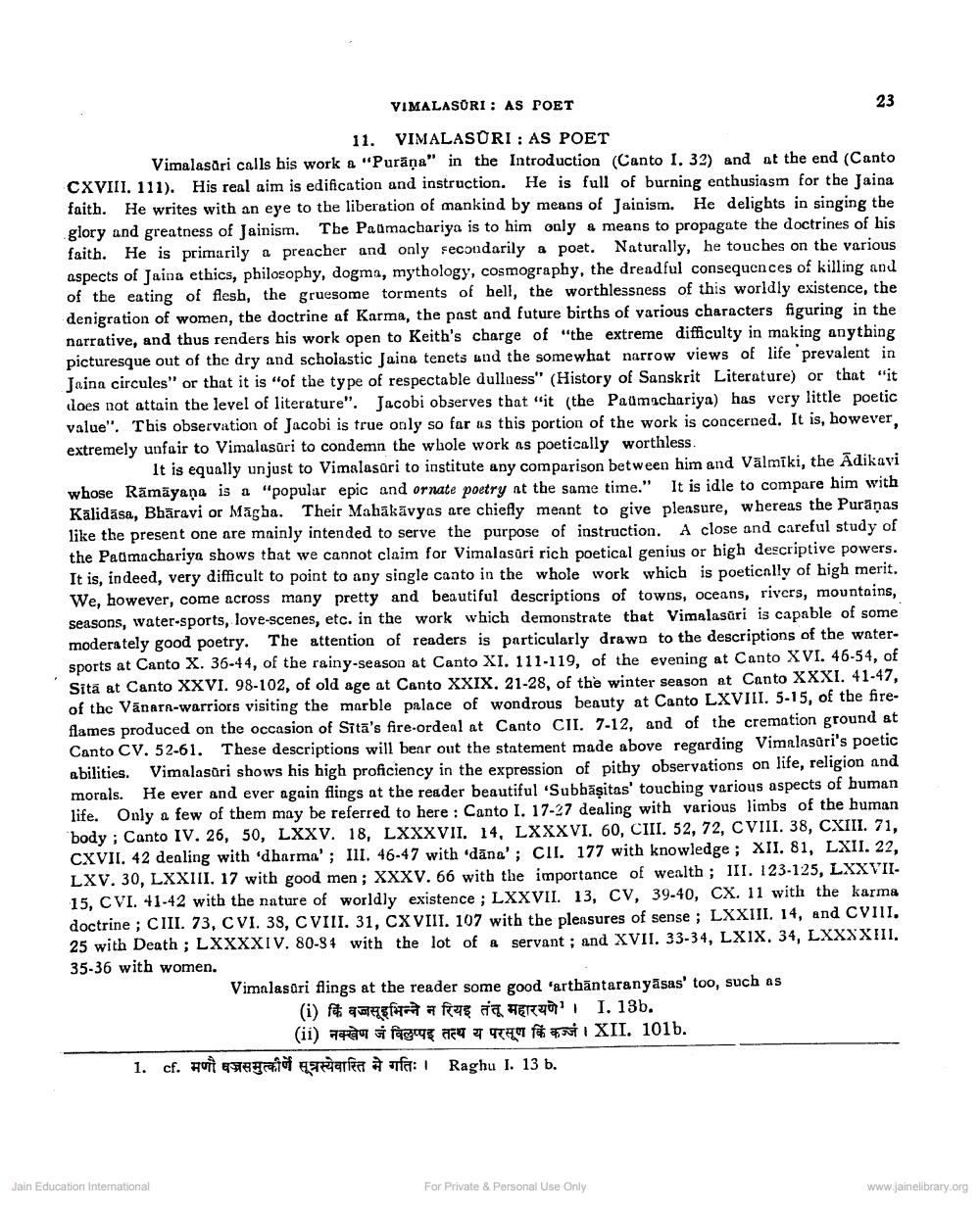________________
VIMALASORI: AS POET
11. VIMALASORI: AS POET Vimalasari calls his work a "Purāņa" in the Introduction (Canto I. 32) and at the end (Canto CXVIII. 111). His real aim is edification and instruction. He is full of burning enthusiasm for the Jaina faith. He writes with an eye to the liberation of mankind by means of Jainism. He delights in singing the glory and greatness of Jainism. The Palmachariya is to him only a means to propagate the doctrines of his faith. He is primarily a preacher and only secondarily a post. Naturally, he touches on the various aspects of Jaina ethics, philosophy, dogma, mythology, cosmography, the dreadful consequences of killing and of the eating of flesh, the gruesome torments of hell, the worthlessness of this worldly existence, the denigration of women, the doctrine af Karma, the past and future births of various characters figuring in the narrative, and thus renders his work open to Keith's charge of "the extreme difficulty in making anything picturesque out of the dry and scholastic Jaina tenets and the somewhat narrow views of life prevalent in Jaina circules" or that it is "of the type of respectable dullness" (History of Sanskrit Literature) or that "it does not attain the level of literature". Jacobi observes that "it (the Paumachariya) has very little poetic value". This observation of Jacobi is true only so far as this portion of the work is concerned. It is, however, extremely unfair to Vimalasări to condemn the whole work as poetically worthless.
It is equally unjust to Vimalasari to institute any comparison between him and Valmiki, the Adikavi whose Rāmāyaṇa is a "popular epic and ornate poetry at the same time." It is idle to compare him with Kalidasa, Bhāravi or Māgha. Their Mahakāvyas are chiefly meant to give pleasure, whereas the Puranas like the present one are mainly intended to serve the purpose of instruction. A close and careful study of the Padmachariya shows that we cannot claim for Vimalasări rich poetical genius or high descriptive powers. It is, indeed, very difficult to point to any single canto in the whole work which is poeticnlly of high merit. We, however, come across many pretty and beautiful descriptions of towns, oceans, rivers, mountains, seasons, water-sports, love-scenes, etc. in the work which demonstrate that Vimalasūri is capable of some moderately good poetry. The attention of readers is particularly drawn to the descriptions of the watersports at Canto X. 36-44, of the rainy season at Canto XI. 111-119, of the evening at Canto XVI. 46-54, of Sita at Canto XXVI. 98-102, of old age at Canto XXIX, 21-28, of the winter season at Canto XXXI. 41-47, of thc Vānara-warriors visiting the marble palace of wondrous beauty at Canto LXVIII. 5-15, of the fireflames produced on the occasion of Sita's fire-ordeal at Canto CII. 7-12, and of the cremation ground at Canto CV. 52-61. These descriptions will bear out the statement made above regarding Vimalasuri's poetic abilities. Vimalasari shows his high proficiency in the expression of pithy observations on life, religion and morals. He ever and ever again flings at the reader beautiful 'Subhasitas' touching various aspects of human life. Only a few of them may be referred to here : Canto I. 17-27 dealing with various limbs of the human body; Canto IV. 26, 50, LXXV. 18, LXXXVII. 14, LXXXVI. 60, CIII. 52, 72, CVIII. 38, CXIII. 71, CXVII. 42 dealing with dharma'; III. 46-47 with dāna'; CII. 177 with knowledge ; XII. 81, LXII. 22, LXV. 30, LXXIII, 17 with good men ; XXXV. 66 with the importance of wealth ; III. 123-125, LXXVII15, CVI. +1-42 with the nature of worldly existence ; LXXVII. 13, CV, 39-40, CX. 11 with the karma doctrine ; CIII. 73, CVI. 38, CVIII. 31, CXVIII. 107 with the pleasures of sense ; LXXIII, 14, and CVIII. 25 with Death ; LXXXXIV. 80-84 with the lot of a servant ; and XVII. 33-34, LXIX, 34, LXXXXIII. 35-36 with women.
Vimalasari flings at the reader some good 'arthāntaranyāsas' too, such as
(i) fame a free @ HEROI I. 13b.
(ii) Het fage au 2 a 5 | XII. 101b. 1. cf. Hoit gra f a: Raghu I. 13 b.
Jain Education International
For Private & Personal Use Only
www.jainelibrary.org




